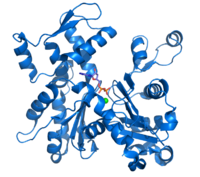
Photo from wikipedia
AKI is a devastating condition with high morbidity and mortality. The pathologic features of AKI are characterized by tubular injury, inflammation, and vascular impairment. Whether fibroblasts in the renal interstitium… Click to show full abstract
AKI is a devastating condition with high morbidity and mortality. The pathologic features of AKI are characterized by tubular injury, inflammation, and vascular impairment. Whether fibroblasts in the renal interstitium have a role in the pathogenesis of AKI is unknown. In this study, we investigated the role of fibroblast-specific β-catenin signaling in dictating the outcome of AKI, using conditional knockout mice in which β-catenin was specifically ablated in fibroblasts (Gli1-β-cat-/-). After ischemia-reperfusion injury (IRI), Gli1-β-cat-/- mice had lower serum creatinine levels and less morphologic injury than Gli1-β-cat+/+ littermate controls. Moreover, we detected fewer apoptotic cells, as well as decreased cytochrome C release; reduced expression of Bax, FasL, and p53; and increased phosphorylation of Akt, in the Gli1-β-cat-/- kidneys. Gli1-β-cat-/- kidneys also exhibited upregulated expression of proliferating cell nuclear antigen and Ki-67, which are markers of cell proliferation. Furthermore, Gli1-β-cat-/- kidneys displayed suppressed NF-κB signaling and cytokine expression and reduced infiltration of inflammatory cells. Notably, loss of β-catenin in fibroblasts induced renal expression of hepatocyte growth factor (HGF) and augmented the tyrosine phosphorylation of c-met receptor after IRI. In vitro, treatment with Wnt ligands or ectopic expression of active β-catenin inhibited HGF mRNA and protein expression and repressed HGF promoter activity. Collectively, these results suggest that fibroblast-specific β-catenin signaling can control tubular injury and repair in AKI by modulating HGF expression. Our studies uncover a previously unrecognized role for interstitial fibroblasts in the pathogenesis of AKI.
Journal Title: Journal of the American Society of Nephrology : JASN
Year Published: 2018
Link to full text (if available)
Share on Social Media: Sign Up to like & get
recommendations!